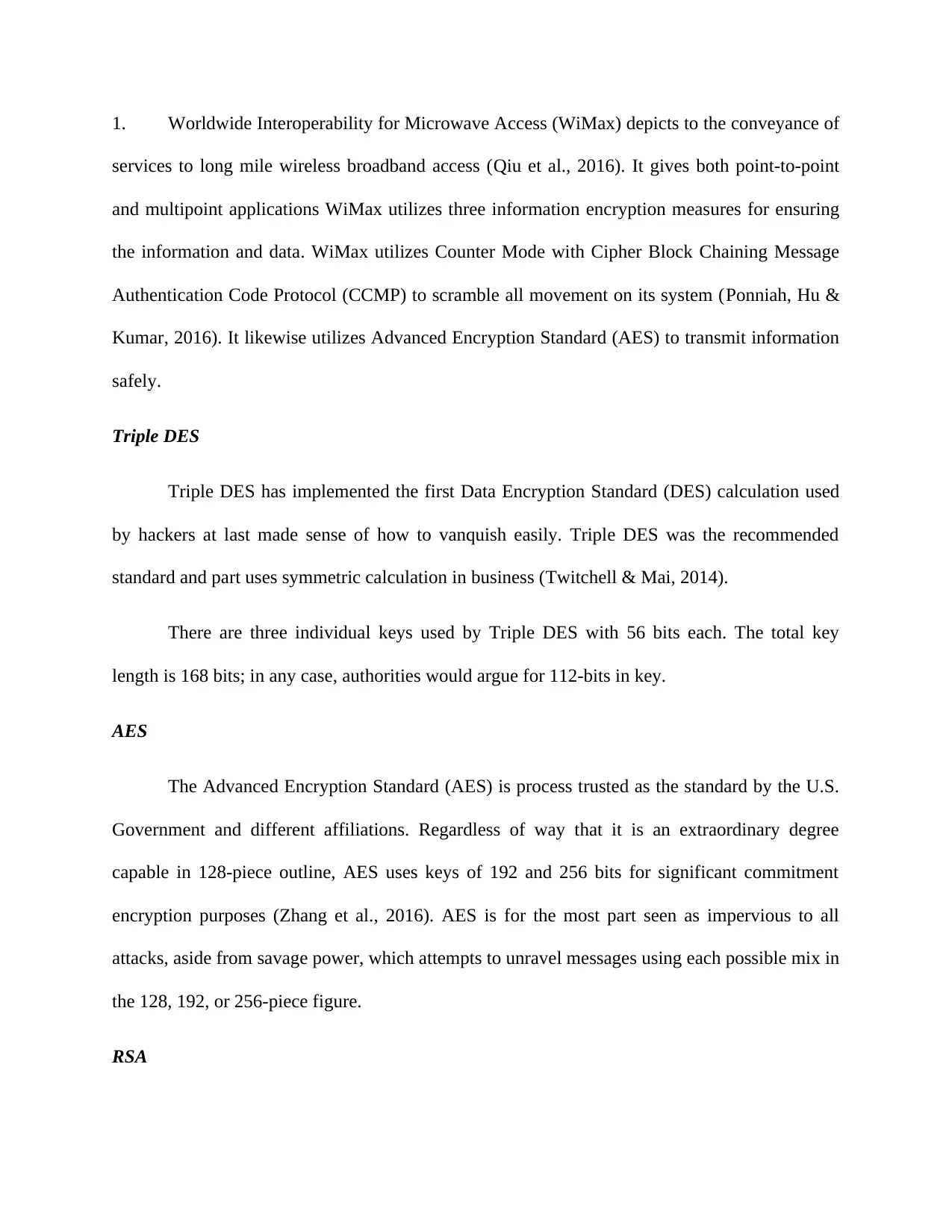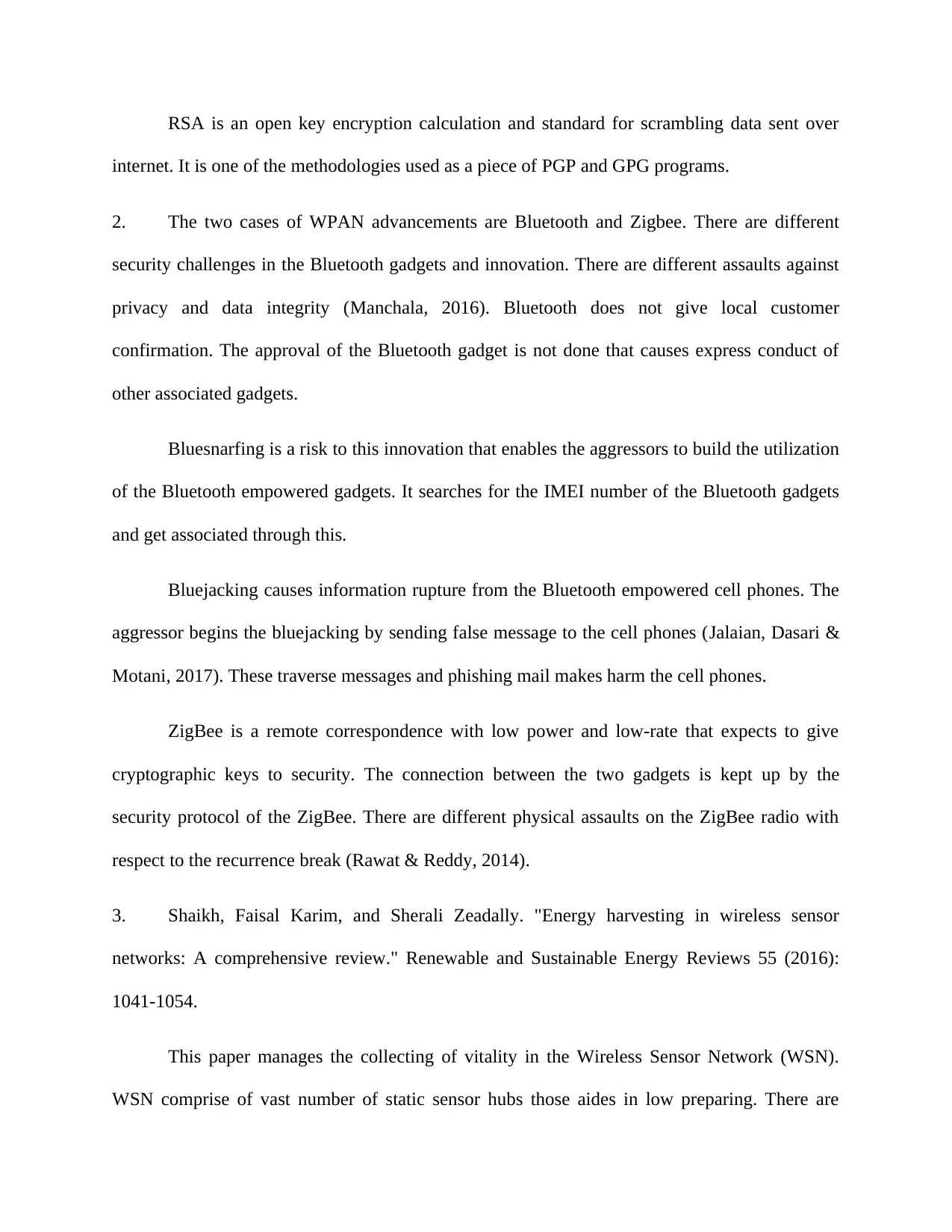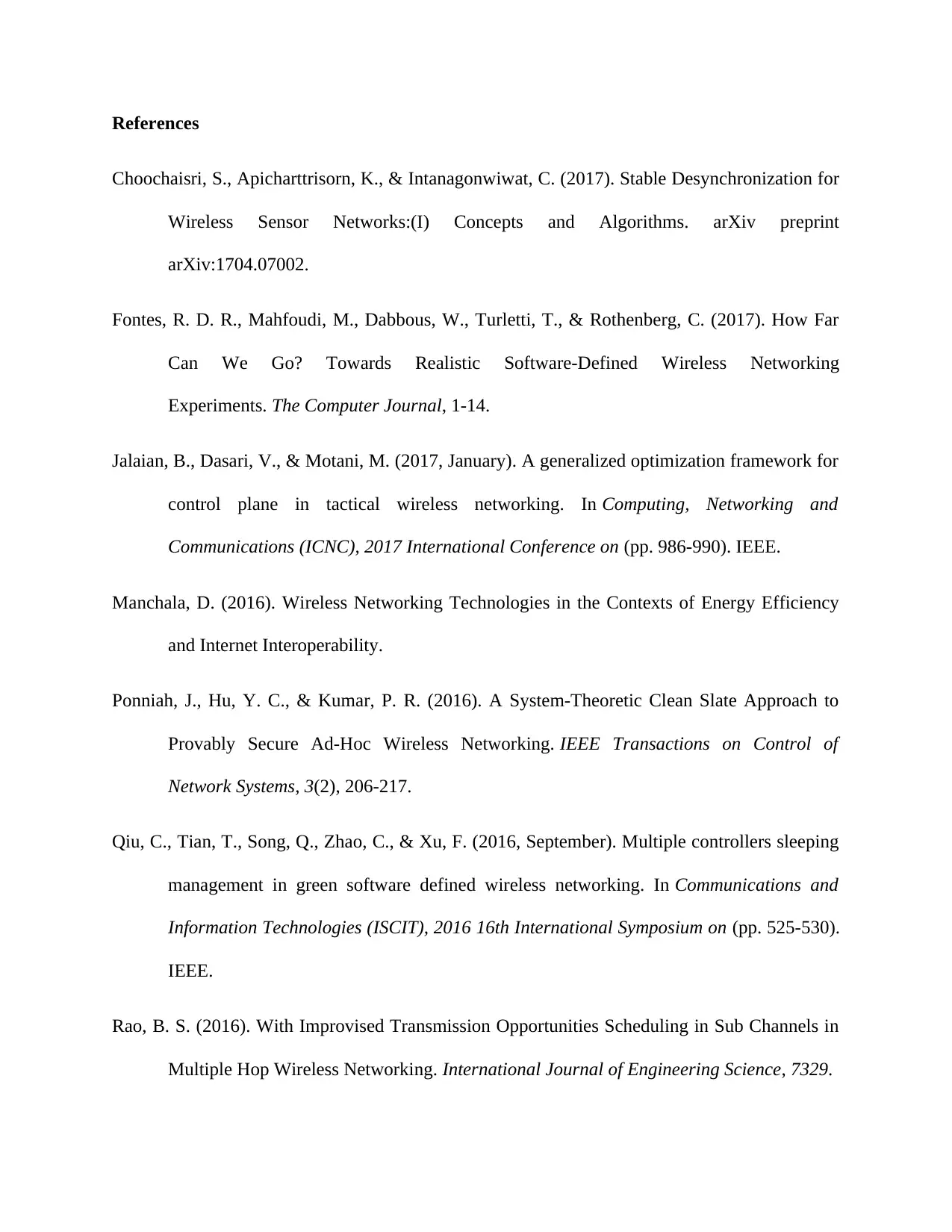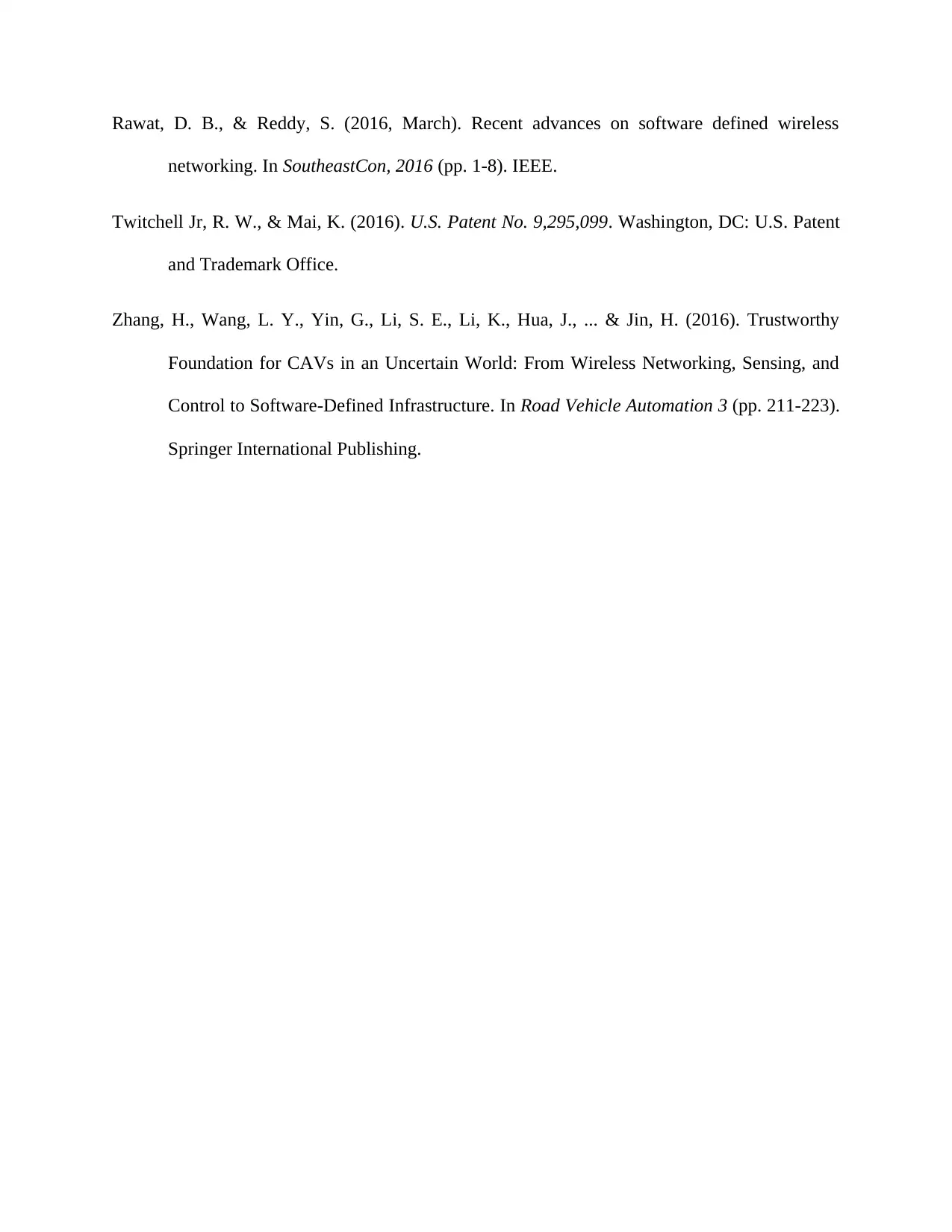Wireless Networking Security Concepts
VerifiedAdded on 2020/04/07
|6
|1263
|64
AI Summary
This assignment delves into the concepts of wireless networking security, focusing on protocols like WiMax, AES, and Triple DES. It analyzes the security vulnerabilities and challenges associated with Bluetooth and ZigBee technologies. Furthermore, it explores the role of energy harvesting in Wireless Sensor Networks (WSNs) and its implications for network security.
Contribute Materials
Your contribution can guide someone’s learning journey. Share your
documents today.

Wireless networking Concept
Name of the Student
Name of the University
Author’s Note
Name of the Student
Name of the University
Author’s Note
Secure Best Marks with AI Grader
Need help grading? Try our AI Grader for instant feedback on your assignments.

1. Worldwide Interoperability for Microwave Access (WiMax) depicts to the conveyance of
services to long mile wireless broadband access (Qiu et al., 2016). It gives both point-to-point
and multipoint applications WiMax utilizes three information encryption measures for ensuring
the information and data. WiMax utilizes Counter Mode with Cipher Block Chaining Message
Authentication Code Protocol (CCMP) to scramble all movement on its system (Ponniah, Hu &
Kumar, 2016). It likewise utilizes Advanced Encryption Standard (AES) to transmit information
safely.
Triple DES
Triple DES has implemented the first Data Encryption Standard (DES) calculation used
by hackers at last made sense of how to vanquish easily. Triple DES was the recommended
standard and part uses symmetric calculation in business (Twitchell & Mai, 2014).
There are three individual keys used by Triple DES with 56 bits each. The total key
length is 168 bits; in any case, authorities would argue for 112-bits in key.
AES
The Advanced Encryption Standard (AES) is process trusted as the standard by the U.S.
Government and different affiliations. Regardless of way that it is an extraordinary degree
capable in 128-piece outline, AES uses keys of 192 and 256 bits for significant commitment
encryption purposes (Zhang et al., 2016). AES is for the most part seen as impervious to all
attacks, aside from savage power, which attempts to unravel messages using each possible mix in
the 128, 192, or 256-piece figure.
RSA
services to long mile wireless broadband access (Qiu et al., 2016). It gives both point-to-point
and multipoint applications WiMax utilizes three information encryption measures for ensuring
the information and data. WiMax utilizes Counter Mode with Cipher Block Chaining Message
Authentication Code Protocol (CCMP) to scramble all movement on its system (Ponniah, Hu &
Kumar, 2016). It likewise utilizes Advanced Encryption Standard (AES) to transmit information
safely.
Triple DES
Triple DES has implemented the first Data Encryption Standard (DES) calculation used
by hackers at last made sense of how to vanquish easily. Triple DES was the recommended
standard and part uses symmetric calculation in business (Twitchell & Mai, 2014).
There are three individual keys used by Triple DES with 56 bits each. The total key
length is 168 bits; in any case, authorities would argue for 112-bits in key.
AES
The Advanced Encryption Standard (AES) is process trusted as the standard by the U.S.
Government and different affiliations. Regardless of way that it is an extraordinary degree
capable in 128-piece outline, AES uses keys of 192 and 256 bits for significant commitment
encryption purposes (Zhang et al., 2016). AES is for the most part seen as impervious to all
attacks, aside from savage power, which attempts to unravel messages using each possible mix in
the 128, 192, or 256-piece figure.
RSA

RSA is an open key encryption calculation and standard for scrambling data sent over
internet. It is one of the methodologies used as a piece of PGP and GPG programs.
2. The two cases of WPAN advancements are Bluetooth and Zigbee. There are different
security challenges in the Bluetooth gadgets and innovation. There are different assaults against
privacy and data integrity (Manchala, 2016). Bluetooth does not give local customer
confirmation. The approval of the Bluetooth gadget is not done that causes express conduct of
other associated gadgets.
Bluesnarfing is a risk to this innovation that enables the aggressors to build the utilization
of the Bluetooth empowered gadgets. It searches for the IMEI number of the Bluetooth gadgets
and get associated through this.
Bluejacking causes information rupture from the Bluetooth empowered cell phones. The
aggressor begins the bluejacking by sending false message to the cell phones (Jalaian, Dasari &
Motani, 2017). These traverse messages and phishing mail makes harm the cell phones.
ZigBee is a remote correspondence with low power and low-rate that expects to give
cryptographic keys to security. The connection between the two gadgets is kept up by the
security protocol of the ZigBee. There are different physical assaults on the ZigBee radio with
respect to the recurrence break (Rawat & Reddy, 2014).
3. Shaikh, Faisal Karim, and Sherali Zeadally. "Energy harvesting in wireless sensor
networks: A comprehensive review." Renewable and Sustainable Energy Reviews 55 (2016):
1041-1054.
This paper manages the collecting of vitality in the Wireless Sensor Network (WSN).
WSN comprise of vast number of static sensor hubs those aides in low preparing. There are
internet. It is one of the methodologies used as a piece of PGP and GPG programs.
2. The two cases of WPAN advancements are Bluetooth and Zigbee. There are different
security challenges in the Bluetooth gadgets and innovation. There are different assaults against
privacy and data integrity (Manchala, 2016). Bluetooth does not give local customer
confirmation. The approval of the Bluetooth gadget is not done that causes express conduct of
other associated gadgets.
Bluesnarfing is a risk to this innovation that enables the aggressors to build the utilization
of the Bluetooth empowered gadgets. It searches for the IMEI number of the Bluetooth gadgets
and get associated through this.
Bluejacking causes information rupture from the Bluetooth empowered cell phones. The
aggressor begins the bluejacking by sending false message to the cell phones (Jalaian, Dasari &
Motani, 2017). These traverse messages and phishing mail makes harm the cell phones.
ZigBee is a remote correspondence with low power and low-rate that expects to give
cryptographic keys to security. The connection between the two gadgets is kept up by the
security protocol of the ZigBee. There are different physical assaults on the ZigBee radio with
respect to the recurrence break (Rawat & Reddy, 2014).
3. Shaikh, Faisal Karim, and Sherali Zeadally. "Energy harvesting in wireless sensor
networks: A comprehensive review." Renewable and Sustainable Energy Reviews 55 (2016):
1041-1054.
This paper manages the collecting of vitality in the Wireless Sensor Network (WSN).
WSN comprise of vast number of static sensor hubs those aides in low preparing. There are

different wellsprings of vitality for the WSNs including Radio Frequency-based vitality
collecting, Solar-based vitality gathering, Thermal-based Energy Harvesting and Flow-based
vitality reaping. There are different methodologies talked about in the paper for the vitality
collecting. As contended by Rao (2016), the vitality gathering framework may make harm the
environmental adjust of the nature. The collecting from various sources causes consumption of
the assets in the earth. Choochaisri, Apicharttrisorn and Intanagonwiwat, (2017) contended that
log enduring gadgets devours more battery and causes vitality depleting.
Ulukus, Sennur, et al. "Energy harvesting wireless communications: A review of recent
advances." IEEE Journal on Selected Areas in Communications 33.3 (2015): 360-381.
This paper talks about the new advances executed in the vitality gathering division. As
remarked by Fontes et al., (2017), the new advances in the vitality gathering have changed the
customary situation of vitality reaping. Choochaisri, Apicharttrisorn and Intanagonwiwat, (2017)
argued that the utilization of the advanced strategies in the vitality gathering have expands the
underlying expense of different vitality sources and furthermore exhausting the regular assets.
Different conditions and speculations talked about in the paper that uses the conventional idea of
vitality gathering and changing over it into current innovation (Jalaian, Dasari & Motani, 2017).
collecting, Solar-based vitality gathering, Thermal-based Energy Harvesting and Flow-based
vitality reaping. There are different methodologies talked about in the paper for the vitality
collecting. As contended by Rao (2016), the vitality gathering framework may make harm the
environmental adjust of the nature. The collecting from various sources causes consumption of
the assets in the earth. Choochaisri, Apicharttrisorn and Intanagonwiwat, (2017) contended that
log enduring gadgets devours more battery and causes vitality depleting.
Ulukus, Sennur, et al. "Energy harvesting wireless communications: A review of recent
advances." IEEE Journal on Selected Areas in Communications 33.3 (2015): 360-381.
This paper talks about the new advances executed in the vitality gathering division. As
remarked by Fontes et al., (2017), the new advances in the vitality gathering have changed the
customary situation of vitality reaping. Choochaisri, Apicharttrisorn and Intanagonwiwat, (2017)
argued that the utilization of the advanced strategies in the vitality gathering have expands the
underlying expense of different vitality sources and furthermore exhausting the regular assets.
Different conditions and speculations talked about in the paper that uses the conventional idea of
vitality gathering and changing over it into current innovation (Jalaian, Dasari & Motani, 2017).
Secure Best Marks with AI Grader
Need help grading? Try our AI Grader for instant feedback on your assignments.

References
Choochaisri, S., Apicharttrisorn, K., & Intanagonwiwat, C. (2017). Stable Desynchronization for
Wireless Sensor Networks:(I) Concepts and Algorithms. arXiv preprint
arXiv:1704.07002.
Fontes, R. D. R., Mahfoudi, M., Dabbous, W., Turletti, T., & Rothenberg, C. (2017). How Far
Can We Go? Towards Realistic Software-Defined Wireless Networking
Experiments. The Computer Journal, 1-14.
Jalaian, B., Dasari, V., & Motani, M. (2017, January). A generalized optimization framework for
control plane in tactical wireless networking. In Computing, Networking and
Communications (ICNC), 2017 International Conference on (pp. 986-990). IEEE.
Manchala, D. (2016). Wireless Networking Technologies in the Contexts of Energy Efficiency
and Internet Interoperability.
Ponniah, J., Hu, Y. C., & Kumar, P. R. (2016). A System-Theoretic Clean Slate Approach to
Provably Secure Ad-Hoc Wireless Networking. IEEE Transactions on Control of
Network Systems, 3(2), 206-217.
Qiu, C., Tian, T., Song, Q., Zhao, C., & Xu, F. (2016, September). Multiple controllers sleeping
management in green software defined wireless networking. In Communications and
Information Technologies (ISCIT), 2016 16th International Symposium on (pp. 525-530).
IEEE.
Rao, B. S. (2016). With Improvised Transmission Opportunities Scheduling in Sub Channels in
Multiple Hop Wireless Networking. International Journal of Engineering Science, 7329.
Choochaisri, S., Apicharttrisorn, K., & Intanagonwiwat, C. (2017). Stable Desynchronization for
Wireless Sensor Networks:(I) Concepts and Algorithms. arXiv preprint
arXiv:1704.07002.
Fontes, R. D. R., Mahfoudi, M., Dabbous, W., Turletti, T., & Rothenberg, C. (2017). How Far
Can We Go? Towards Realistic Software-Defined Wireless Networking
Experiments. The Computer Journal, 1-14.
Jalaian, B., Dasari, V., & Motani, M. (2017, January). A generalized optimization framework for
control plane in tactical wireless networking. In Computing, Networking and
Communications (ICNC), 2017 International Conference on (pp. 986-990). IEEE.
Manchala, D. (2016). Wireless Networking Technologies in the Contexts of Energy Efficiency
and Internet Interoperability.
Ponniah, J., Hu, Y. C., & Kumar, P. R. (2016). A System-Theoretic Clean Slate Approach to
Provably Secure Ad-Hoc Wireless Networking. IEEE Transactions on Control of
Network Systems, 3(2), 206-217.
Qiu, C., Tian, T., Song, Q., Zhao, C., & Xu, F. (2016, September). Multiple controllers sleeping
management in green software defined wireless networking. In Communications and
Information Technologies (ISCIT), 2016 16th International Symposium on (pp. 525-530).
IEEE.
Rao, B. S. (2016). With Improvised Transmission Opportunities Scheduling in Sub Channels in
Multiple Hop Wireless Networking. International Journal of Engineering Science, 7329.

Rawat, D. B., & Reddy, S. (2016, March). Recent advances on software defined wireless
networking. In SoutheastCon, 2016 (pp. 1-8). IEEE.
Twitchell Jr, R. W., & Mai, K. (2016). U.S. Patent No. 9,295,099. Washington, DC: U.S. Patent
and Trademark Office.
Zhang, H., Wang, L. Y., Yin, G., Li, S. E., Li, K., Hua, J., ... & Jin, H. (2016). Trustworthy
Foundation for CAVs in an Uncertain World: From Wireless Networking, Sensing, and
Control to Software-Defined Infrastructure. In Road Vehicle Automation 3 (pp. 211-223).
Springer International Publishing.
networking. In SoutheastCon, 2016 (pp. 1-8). IEEE.
Twitchell Jr, R. W., & Mai, K. (2016). U.S. Patent No. 9,295,099. Washington, DC: U.S. Patent
and Trademark Office.
Zhang, H., Wang, L. Y., Yin, G., Li, S. E., Li, K., Hua, J., ... & Jin, H. (2016). Trustworthy
Foundation for CAVs in an Uncertain World: From Wireless Networking, Sensing, and
Control to Software-Defined Infrastructure. In Road Vehicle Automation 3 (pp. 211-223).
Springer International Publishing.
1 out of 6
Related Documents
Your All-in-One AI-Powered Toolkit for Academic Success.
+13062052269
info@desklib.com
Available 24*7 on WhatsApp / Email
![[object Object]](/_next/static/media/star-bottom.7253800d.svg)
Unlock your academic potential
© 2024 | Zucol Services PVT LTD | All rights reserved.





